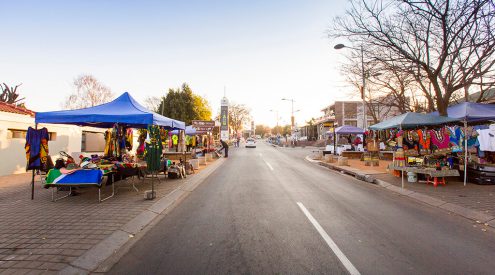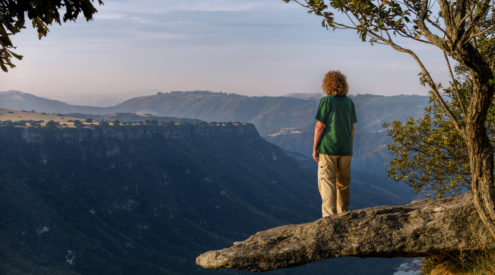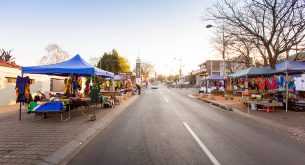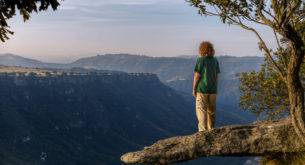I have been lucky enough in my life to travel extensively, and so when it came to country number 50 on my list I was looking for somewhere that could deliver. I had in my mind a pretty good picture of what I expected from Uganda, although I was not expecting just how vast Lake Victoria is, as I approached Entebbe airport. I was destined for the Queen Elizabeth Bush Camp in the Queen Elizabeth National Park.
The sense of elation of landing in a new country was quickly set aside as I settled in for the long drive from Entebbe to downtown Kampala, at night. Driving in Africa after dark can be a terrifying experience, especially in a city where the road is obscured by dust, the street lamps are off due to load-shedding and thousands and thousands of people are walking along the edges of the road, or just leaping out into the oncoming traffic in a suicidal bid to reach the other side.
Gridlock as we approached the centre turned the journey into a two hour nightmare, so I was glad to see my hotel loom ahead of me. By morning the experiences of the previous night had passed and I enjoyed the views across the many hills that make up Kampala. Most cities are comprised of a central business district around which are suburbs where people live. Kampala, however, seems to be just one big central business district, with the population all choosing to live in the surrounding towns and villages, as far as Entebbe itself. Never a huge fan of cities, I soon left and headed west.
Uganda is a very hilly country, and the valleys are coated in thick fog until late morning. Red dust covers everything, but the lushness of the vegetation was fascinating compared to the arid landscape of my home in Zambia. We passed through many plantations of tea until, as we approached Fort Portal and the Rwenzori Mountains loomed up ahead, bananas took over as the crop of choice. Heading south I arrived into my destination; Queen Elizabeth National Park.
I was staying at the Queen Elizabeth Bush Camp, an extremely basic accommodation even by bush camp standards (sold as Mid-Range by the tour operator) but it overlooked the Kazinga Channel so the scenery more than made up for the facilities. From my room I could watch elephants and hippos in the waters below whilst flocks of birds traversed the waterway. As the sun rose on the next day I could hear lions on the other side of the channel roaring and looked forward to driving into the park itself. I headed into the Kasenyi section, a sea of grass studded by islands of dense thicket. Two hyena provided much entertainment as they consumed a recently killed Uganda kob, whilst the sight of mating lions not much further drew the crowds (5 vehicles). They were perfect binocular distance but just too far for my camera. As with all of Africa, lions in Uganda are facing an uncertain future. Populations have been decreasing sharply across the country and there are estimated to only be 415 (Wildlife Conservation Society, 2009) left, down from nearly 700 (Chardonnet, 2002) just a decade ago. Conflict with people and the removal of the lion’s prey base through poaching, combined with considerable human encroachment into the national park areas are seen as the principle contributors. So it was good to see these two lions doing their bit to increase the numbers of lions in Queen Elizabeth National Park.
Bird life around the park and in the Kasinga Channel is prolific, and whilst mammal sightings are common, most times the animals are quite some distance away.
In the afternoon I took advantage of a boat cruise on the channel which afforded close up views of hundreds of buffalo and many elephant taking advantage of the cool waters. As the cruise made its lazy way along the channel and to the edge of Lake Edward, we came across fishing villages with many boats bobbing up and down in the surf. Children played in the water alongside buffalo and thousands of birds filled the banks and air.
On my return to the lodge I encountered a new species for me; a family of giant forest hogs crossed my path. I had no idea they could be so big, and from a distance my mind was finding it hard to work out what was ahead of me. The family had some tiny piglets with them, and after watching me for a while they trotted off into the dense undergrowth.
I awoke again the next morning to the sounds of lions, a resonant boom that cannot be beaten to ensure you know where you are. A short drive away brought me to a huge gash in the landscape; the Kyambura Gorge. 11 km long and 100 m deep this impressive and surprising feature in the landscape is home to six primate species. With my guide I headed down into the gorge, but not before he explained a 100 ways to die down there, but nevertheless, the aim was simple; to find the gorge’s most notable residents.
The foliage was dense although several well-worn paths made the going easier. In the trees high above you could catch glimpses of baboon, black and white colobus monkeys and red-tailed monkeys. After an hour or so a familiar shriek was heard and our guide invited me to run over fallen logs, through bushes and over a rickety bridge towards the sound. And there, in the path ahead of me was a wild chimpanzee. Others soon appeared around us and I was enthralled to watch these beautiful creatures move through the forest – my first wild chimps. This family of 20 or so has now been cut off from other populations to the south as human development has isolated them in this small island in a sea of grass.
This tour was organized by Katona Tours and Travel, based in Kampala.
Explore Africa’s incredible wildlife with one of these unique Uganda travel packages from Getaway Adventures.
















